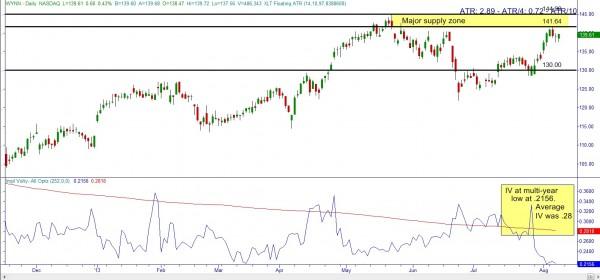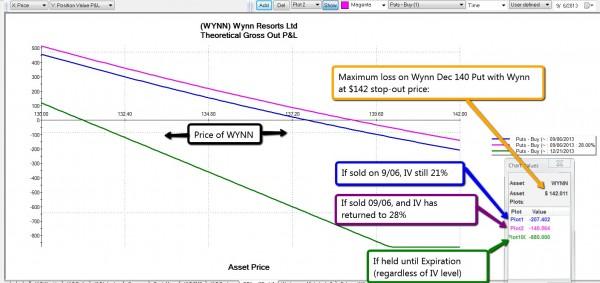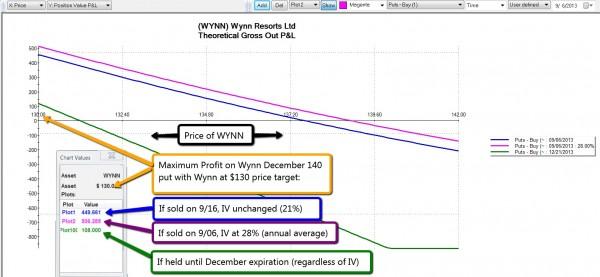In last week’s article, which you can read here, I started an example of a low-volatility option opportunity. Low volatility is just another term for cheap options. We like to buy things cheap. This week we’ll wrap up that example.
I listed the steps in the process of identifying low-volatility opportunities earlier. Last week we went through steps 1-6 in detail. This week we’ll cover the rest of the steps, and check on the progress of the trade.
In the following discussion, I’ll summarize the first 6 steps, already covered, in a few words.
1. Locate stocks with currently unusually low Implied Volatility (IV) – relative to their own IV history). Low IV means cheap options.
We found 39 stocks whose IV was in the bottom 5% of their previous year’s range.
2. Using a daily price chart, determine if we have a good reason to be strongly bullish or strongly bearish on each stock. This will be the case only if the stock is near (within an average day’s range of) a high-probability turning point – a high-quality supply or demand level. Furthermore, there must be plenty of room for the stock to move after its reversal, enough for at least a 3:1 reward-to-risk ratio. Reject all the stocks that fail this test. This will eliminate most of the possibilities. The remaining stocks, if any, are our choicest opportunities.
We found one good candidate, Wynn Resorts Ltd (WYNN), near a strong supply level.
Wynn’s price chart at that time is reproduced below.
Figure 1 – WYNN price chart as of August 8, 2013
3. Identify the stop price that we would be using if we were going to trade the stock itself. At what price would we exit the trade if it went against us?
We set this at $142.00, just above a recent high of $141.64. WYNN was at $139.68 at the time.
4. Identify the target price for the next 30 days. At what price would we take our profit and exit the trade if it went our way during that time?
We used $130, the price level where the most recent rally originated.
5. On the stock’s option chain, locate the nearest monthly expiration date that is more than 90 days away.
With choices of September (44 days) or December (135 days), we selected December.
6. For that expiration date, find the first in-the-money (ITM) strike price. If we are bullish and using Call options, that is the next strike price below the current stock price; if we are bearish and using Put options, it is the next strike price above the current price.
The first In-the-money put was the 140 put, which we could buy for $880 per contract.
Below is the option chain for WYNN.
Figure 2 – WYNN option chain as of August 8, 2013
Now for the remaining steps, which we’ll cover in detail.
7. Calculate profit amount, with the stock at the target price and IV unchanged, 30 days from now. You must use option diagramming software for this (details below).
For steps 7-9, we used the Tradestation module called OptionStation to diagram the trade and calculate profit/loss amounts.
Below is a diagram showing the profit/loss amounts on the December 140 puts, at any WYNN price between $130 and $142.
Figure 3 – WYNN December 140 Puts, comparison of Maximum Profit at the $142 Target Price
In the diagram above, three separate lines are plotted:
The blue line (plot1) shows the P/L as of a date 30 days in the future, assuming no change in IV.
The magenta line (plot2) also shows P/L as of a date 30 days out, but assuming IV increases to 28% (the average IV for this stock over the past year).
The green line (plot100) shows the P/L picture 135 days out, at the December expiration date.
The Chart Values box at the lower left shows us how much profit the put would make with WYNN at the $130 price target, in each of those three situations. With WYNN at the $130 target, if it were reached 30 days from the entry date on September 6, our puts would make $449.66 each, if WYNN stayed at its ultra-low IV level (Plot1). If at that same date the IV were to increase to its 28% average, the puts would make $506.28 each (Plot2). That $56.62 difference ($506.28 vs $449.66) shows the effect that an increase in IV, from the current 21% up to the average of 28%, would have on our P/L. The actual IV change could be greater or smaller than that; IV could conceivably even go down. But since WYNN was at a historic low in IV, we thought an increase was more likely.
The value for Plot100 in the Chart Values box is $108.00. That is the amount this same put would make at that same $130 price of WYNN, if the put were held all the way until expiration. The difference between the Plot1 value of $449.66 and the Plot100 value of $108.00($449.66 – $108.00 = $341.66), is the amount of time value that would be left in the puts on September 6 vs the December expiration, assuming unchanged IV. That $341.66 is the reason we do not plan to hold these puts any longer than 30 days. We need to sell the puts while they still have most of their time value. Now for step 8:
8. Calculate the loss amount, with the stock at the stop price and IV unchanged, 30 days from now. Reject the trade if the 30-days-out reward-to-risk ratio is less than 2 to 1.
Below is the same diagram, this time labeled to show the loss amounts for the put position, if WYNN were to rise to our stop-out price of $142.
Figure 4 – WYNN December 140 Puts, comparison of Maximum Loss Amount at the $142 Stop Price
The Chart Values box now shows the loss amounts in the case where WYNN rises to our $142 stop price. As of our September 6 target date, our loss would be $-207.40 if IV remained unchanged (Plot1). It would be only $-140.56 if IV increased to 28% (Plot2). That difference of $66.84 ($207.40 – $140.56) is the amount our maximum loss would be reduced if the 28% IV increase occurred.
The value for Plot100 is $-880.00. That is the amount of loss we would suffer if we held the 140 puts all the way until expiration and they expired worthless. It the full cost of the puts at $880 per contract. You can now see clearly why we don’t want to hold them that long.
As you can see, modeling/diagramming software is absolutely required in order to estimate profit or loss for option positions that we plan not to hold until expiration. There is no “quick and dirty” way to do it.
We can now calculate our reward to risk ratio assuming unchanged IV.
Our Reward/Risk ratio is $449.66/$207.40 = 2.16 to 1.
The $449.66 figure is our profit at WYNN at the 130 target on September 6 and unchanged IV, the Plot1 value from Figure 3 above.
The $207.40 is our loss with WYNN at the 142 stop price on September 6 and unchanged IV, the Plot1 value from Figure 4 above.
Since our P/L at unchanged IV is greater than 2 to 1, we could continue to consider this trade. Now for step 9.
9. Recalculate the 30-days-out profit and loss amounts, and reward-to-risk ratio, assuming that IV increases back to its one-year average. Reject the trade if the reward-to-risk ratio is not at least 3:1.
In diagramming the trade, we plotted a line that was 30 days out with IV at the 28% average. So it’s now easy to calculate our Risk/Reward in that case as $506.28/$140.56 = 3.6 to 1.
Note how much that projected increase in IV would help us. Compared to the situation with unchanged IV, it would increase our max profit by $56.62 ($506.28 - $449.66); decrease our max loss by $66.84 ($207.40 - $140.56); and improve our Reward/Risk ratio from 2.1 to 3.6.
This is why we chose puts that were very close to the stock’s original price, with a long time to run. In a situation where we expect an increase in IV, those puts will benefit the most.
Since our higher-IV Reward/Risk ratio exceeded our 3:1 minimum requirement, the trade was a go, so on to step 10.
10. If all still looks good, place the trade.
It did, so we did. We Bought to Open the puts at $8.80, using a Limit order.
11. Enter the order(s) to unwind the trade if the underlying hits the stop price.
We entered an order to Buy to Close the puts using a Market order, conditional on WYNN either trading at or above $142, or trading at or below $130, good ‘til canceled.
A week after entering the trade, WYNN was almost where it had been when we entered. The puts were also still within 5 cents of the price where we bought them. Our exit plans were in place, and all we had to do was to wait for one of our triggers to take us out of the trade.
In these last four articles, We’ve now walked through the steps involved in identifying and placing two very different kinds of trades. The process may at first seem formidable, but each step on its own is simple. Mastering the process is the key to profitable option trading.
This content is intended to provide educational information only. This information should not be construed as individual or customized legal, tax, financial or investment services. As each individual's situation is unique, a qualified professional should be consulted before making legal, tax, financial and investment decisions. The educational information provided in this article does not comprise any course or a part of any course that may be used as an educational credit for any certification purpose and will not prepare any User to be accredited for any licenses in any industry and will not prepare any User to get a job. Reproduced by permission from OTAcademy.com click here for Terms of Use: https://www.otacademy.com/about/terms
Editors’ Picks
EUR/USD edges lower toward 1.0700 post-US PCE

EUR/USD stays under modest bearish pressure but manages to hold above 1.0700 in the American session on Friday. The US Dollar (USD) gathers strength against its rivals after the stronger-than-forecast PCE inflation data, not allowing the pair to gain traction.
GBP/USD retreats to 1.2500 on renewed USD strength

GBP/USD lost its traction and turned negative on the day near 1.2500. Following the stronger-than-expected PCE inflation readings from the US, the USD stays resilient and makes it difficult for the pair to gather recovery momentum.
Gold struggles to hold above $2,350 following US inflation

Gold turned south and declined toward $2,340, erasing a large portion of its daily gains, as the USD benefited from PCE inflation data. The benchmark 10-year US yield, however, stays in negative territory and helps XAU/USD limit its losses.
Bitcoin Weekly Forecast: BTC’s next breakout could propel it to $80,000 Premium

Bitcoin’s recent price consolidation could be nearing its end as technical indicators and on-chain metrics suggest a potential upward breakout. However, this move would not be straightforward and could punish impatient investors.
Week ahead – Hawkish risk as Fed and NFP on tap, Eurozone data eyed too

Fed meets on Wednesday as US inflation stays elevated. Will Friday’s jobs report bring relief or more angst for the markets? Eurozone flash GDP and CPI numbers in focus for the Euro.
RECOMMENDED LESSONS
Making money in forex is easy if you know how the bankers trade!
Discover how to make money in forex is easy if you know how the bankers trade!
5 Forex News Events You Need To Know
In the fast moving world of currency markets, it is extremely important for new traders to know the list of important forex news...
Top 10 Chart Patterns Every Trader Should Know
Chart patterns are one of the most effective trading tools for a trader. They are pure price-action, and form on the basis of underlying buying and...
7 Ways to Avoid Forex Scams
The forex industry is recently seeing more and more scams. Here are 7 ways to avoid losing your money in such scams: Forex scams are becoming frequent. Michael Greenberg reports on luxurious expenses, including a submarine bought from the money taken from forex traders. Here’s another report of a forex fraud. So, how can we avoid falling in such forex scams?
What Are the 10 Fatal Mistakes Traders Make
Trading is exciting. Trading is hard. Trading is extremely hard. Some say that it takes more than 10,000 hours to master. Others believe that trading is the way to quick riches. They might be both wrong. What is important to know that no matter how experienced you are, mistakes will be part of the trading process.




